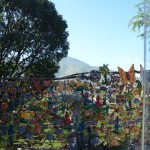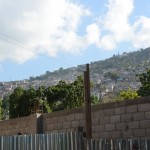The streets are flooded with tap-taps, buses (the van kind) and motorcycle taxis, so it really isn’t that hard to spot them. However, depending on the time of day, it can be next to impossible to find a place on one. Tap-taps are the most cost-effective and most common way to travel. A trip on one will cost anywhere between 1 and 3 haitian dollars (between 12.5 and 37.5 cents US). Most tap-taps are small pickup trucks with a canopy on the back, a wooden bench running down each side of the bed.
Finding one
To find a tap-tap you just flag one going by that has room on it (which is a subjective assessment). Because they have canopies on top, you can’t directly see how many people are already on it – the better indication is how low the truck is riding, or if you see heads on the back peering over top of the canopy. One of the common pickup truck tap-taps has space for 6 people on each bench for a total of 12. But that is by no means at full capacity. You’ll often see 1-2 people standing, bent over, in the middle, available lap space being taken advantage of, and 2-3 people standing on the tailgate. Whether people take advantage of the standing space is dependant on how busy the system currently is, and how desperate the individuals are to get to where they going.
In the area we are in (Delmas 19), there are a couple of different types of hand signals depending on where you want to go. One of the major destinations around PaP is Pétionville (PV), which has a different signal than other places in the signal. To flag a tap-tap going anywhere but PV, you hold your arm out and wiggle your index finger down. If you are headed for PV, you hold your thumb up and repeatedly wave it over your shoulder. Once you have the tap-tap driver’s attention there are a few things that can happen. If you are traveling in a group, you can optionally hold up the number of fingers according to the size of your group. The driver can respond in a number of ways:
- He can ignore you all together.
- Point his finger straight up, indicating standing room only. You respond with either a nod or a shake of your head depending on whether you are willing to stand for the trip
- If you have indicated you want to go to PV, and the driver isn’t going there, he’ll indicate by pointing down back at you, or will just keep driving
- Otherwise he’ll pull over and you jump in the back, squeezing down between any passengers already in the back.
Load em up!
Most of the time the driver will pull over as soon as he feels it is safe (once again “safe” is a relative concept). You simply climb in the back and squeeze down between any customers already on. It is not uncommon for the driver to simply stop in the right lane, blocking traffic (the catalyst for horns to start sounding), so you must be fairly efficient at mounting your ride. Although uncommon, sometimes you must jump on while the truck is still rolling. We haven’t had to do that yet, possibly because the driver feels sorry for the naïve “blan”.
The entrance sequence to the tap-tap is when you’ll have contact with the largest number of your fellow passengers. It isn’t uncommon to have a balancing hand put on your knee, a bag of goods (or perhaps a small child) passed up first for stowing before the rider gets on, or a saving arm wrapped around you, stopping you falling off the back as the driver lurches back into motion before everyone is settled. Sometime during this loading process the truck bounces into motion, and the engine begins to grind up the hill again, which is by no means an easy task if there is a truly full load.
The actual ride itself can be quite nice if you don’t end up in too much traffic – there is usually a decent breeze (dusty and smokey as it might be) coming in through the canopy if it can keep moving. However if you get locked in traffic (which is at least as likely), the ride turns into a bit of a sauna, with the travellers starting to perspire freely, neighbours exchanging sweat with each other.
Paying
There are a few different situations for paying the driver. Often the tap-tap crew is composed of 2 people – the driver and someone to deal with payment. If you are leaving from a starting point (say in Pétionville), payment is collected before the ride leaves. If most of the passengers are jumping on along the way, often the second person will get out of the cab and stand on the tailgate near the end of the ride. He will collect the fares as the tap-tap rolls towards its destination. Otherwise once you get off the truck you go up to the cab and pay on the way.
There is really no indication as to how much you’ll pay for the trip until you go to pay. The vast majority of the trips cost about 2 Haitian Dollars (10 Gourdes), but sometimes they collect 3. We have yet to pay only 1, but I imagine that is reserved for very short trips. They’ll happily give change, but you still need some small bills or change. The other thing that is important to remember is to get your money out before you jump on – it is often next to impossible to get at your pockets once you have shoe-horned yourself onto the bench between your travelling companions.
Getting off
As long as you know where you are (which has been the tricky part so far, as it is often difficult to see anything from within the confines of the canopy), this is by far the easiest part. There are 3 main ways to do it:
- if there is a buzzer button within reach, just press it
- if you are near the front, and the window between the cab and the truck bed is closed, just tap a few times on the window
- otherwise just say “mesi” loud enough for the driver to hear, or one of your fellow passengers that is in the position to do something, and it will be taken care of for you by either method (1) or (2).
Once again, the driver will pull over as soon as possible (most of the time immediately, much to the annoyance of the vehicles behind it, or the pedestrians who happen to be in the way), then you squeeze out of your seat, make your way up the centre of the truck bed, doing your best not to elbow or step on anyone, then hop out the back of the truck. If you haven’t done so already, you pay the driver, and you’re on your way!

An almost-full tap-tap.

















